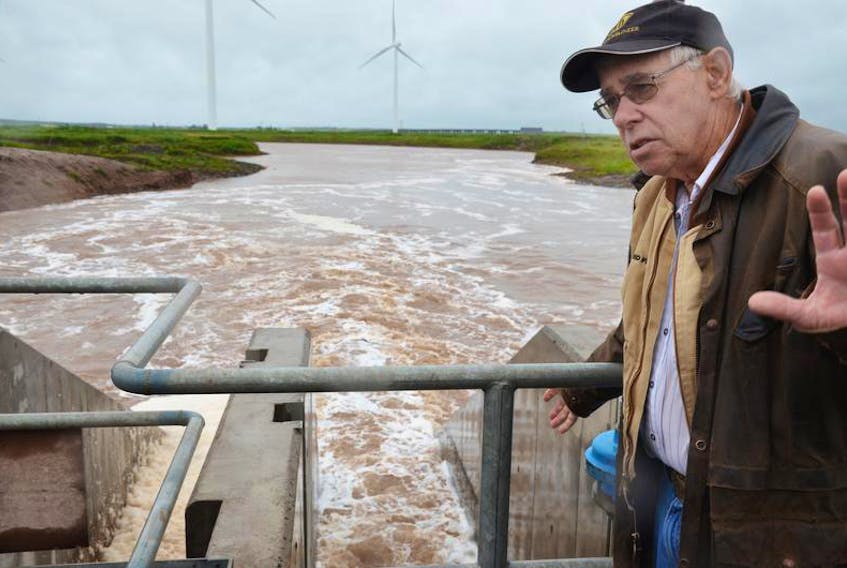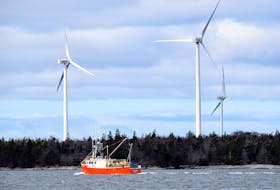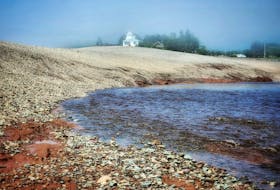Note: Sea levels are rising at a pace unparalleled in modern times and storms are becoming more intense as a result of global warming. This story is part of a weeklong series examining our rising oceans, the impact on our region and what government, scientists and others are doing to track change and mitigate damage.
Click here to read the series.
All Doug Bacon asks is for a bit of a top-up.
The farmer from Upper Nappan in Cumberland County wants to see the earthen dikes that protect his farm land and the properties of neighbouring farmers built up.
“We’re going to get these damn dikes topped up,” said a determined Bacon, who, in his early 70s, still operates a 200-hectare dairy, beef and blueberry operation that employs six people.
“So the water won’t go over the top,” Bacon said, when asked by how much the dikes should be topped up. “I think it should be a continuous maintenance of the dikes and aboiteaux, not just a one-shot deal.”
About 18 months ago, the province completed work on the $5.2-million Laplanche Aboiteau in Amherst to protect farm land and some $40 million in provincial and municipal infrastructure, including roads and railway, from Bay of Fundy flooding.
An aboiteau is a clapper valve or gate built into a dike that swings open at low tide to allow fresh water to drain from farm land but closes at high tide to prevent saltwater from inundating fields.

The Laplanche Aboiteau is found under the protective watch of 20 towering turbines that make up the Amherst wind power project. The aboiteau drains a 133-square-kilometre watershed and provides flood protection for 1,000 hectares of agricultural marshland, according to the provincial Agriculture Department. Provincewide, the department operates and monitors 241 kilometres of dikes and 260 aboiteaux, protecting 17,400 hectares of marshlands.
In June, work was completed on a section of dike along the Cornwallis River between Kentville and New Minas. The $343,000 National Disaster Program project moved a portion of the dike farther back from the river and topped up others parts of the dike to combat rising water level projections. By moving the dike back, part of the land along the river will be reverted to salt marsh, while farm land on the other side of the dike will be protected.
Also in June, Saint Mary’s
University received $1.8-million in federal funds to restore 75 hectares of Fundy marshes through the realignment and decommissioning of dikes at several locations around the bay.
RELATED:
Kevin Bekkers, director of sustainability with the Agriculture Department, said dike work along the Cornwallis River and in other areas are unique climate change mitigations.
“Every one of these is a unique marsh and the solutions for each one is something that has to be done carefully and independently,” Bekkers said. He said a retreat to salt marsh is one option.
Earlier this year, Nova Scotia teamed with New Brunswick to submit a proposal to Ottawa requesting funding for an engineering study to find out what can be done to mitigate pending disaster in the Isthmus of Chignecto, the narrow piece of land connecting the two provinces that is under siege by surging Fundy waters. Each province contributed $175,000, which the federal government matched, to commission a $700,000 study to determine the best way forward.
All good steps but just not enough, according to Bacon, who is the son of former premier Roger Bacon.
Touring a 20-kilometre radius upstream and down from his farmhouse on a rainy morning, Bacon points to what he calls some of the richest farmland in the country — marshland. He can also drive to an area where the antiquated Acadian dikes have been abandoned, leading to regular high-tide flooding and an overgrowth of wild grasses that can’t be harvested.
“Because of the density of the marsh, the density of the soil, it will retain the moisture,” Bacon said. “We’ll see fields in the uplands in a drought year, they’ll dry out and there will be no grass or hay there. They wilt. But on the marshland, you’ll still get a good crop. The moisture is in the soil. It doesn’t dry out as quick.”

But like Valley farmers much farther south along the Fundy, Bacon said the rich farmland is not being protected adequately.
“It’s about agriculture, it’s about cattle and grains and pasture and hay land,” Bacon said. “Agriculture creates the economic benefits for the rural community. We have three feed stores in Amherst, two farm dealerships that employ 15 or 20 people. The spinoff from agriculture is an industry of its own. You’ve got to grow that.”
He said the material to build up the dikes is readily available in the silt that each tide brings in. The silt settles in the borrow pits next to the dikes, trenches dug out previously to build up the dikes.
“The silt will fill up those borrow pits, a regeneration of the topping of your dikes. It would cost hundreds of thousands of dollars to bring material in to top these dikes. This material is here. This material is such that water will not go through it, will not penetrate it.
“They (marshland fields) are crowned so that water runs down the dales to the main drain ditches and out to the sea. This material that we should be using on these dikes is right here. We just have to capture it and raise it over a period of time.”
Instead, Bacon said decisions like the one to leave the Laplanche Aboiteau clapper open for several weeks in late spring at the behest of the provincial Fisheries Department to increase fish numbers are detrimental to agriculture.
“They are defeating the purpose of the aboiteaux.”
Bacon said some of the dikes haven’t been topped up since they were constructed 300 years ago.
“Start with maybe one foot, two feet or three feet, let it dry for one summer and then level it,” he said. “In a few years, put another topping on it, gradually raising it up.”









